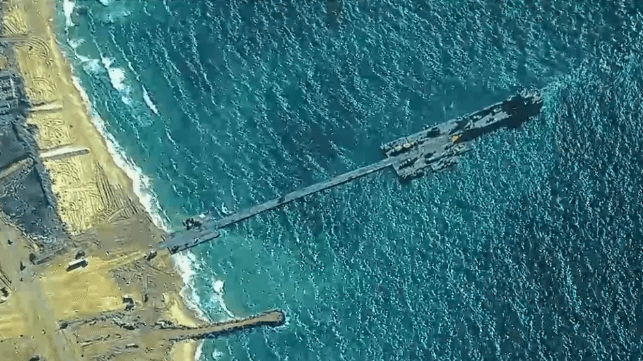Distribution of Food From Gaza Aid Corridor "Paused" Again

Distribution of food aid from the U.S.-operated maritime aid corridor for Gaza has paused once again, one day after repairs to the Pentagon's temporary floating pier were completed. About 500 tonnes of aid has reached shore, but on-the-ground security issues are still preventing the food from reaching the local populace.
The U.S. military has deployed a carefully choreographed, complex cargo delivery system called Joint Logistics Over The Shore (JLOTS) to bring much-needed food aid into Gaza. This expeditionary capability consists of a fair-weather temporary pier, designed to work in conjunction with an offshore receiving station and a flotilla of landing craft. The Pentagon believes that it will be able to handle up to 150 truckloads of aid per day, enough to satisfy about 40 percent of Gaza's typical needs. Contractors are handling the truck-driving delivery from the pier to shore, and the White House has emphasized that no American servicemembers will enter Gaza during the operation. The World Food Programme and a consortium of NGOs are taking care of the distribution on the ground, in consultation with USAID.
In an interview with CBS on Sunday, World Food Program director Cindy McCain said that distribution from the aid pier has been "paused." On Saturday, two warehouses belonging to WFP were "rocketed," McCain said. One WFP staffmember was injured, and WFP and the rest of the humanitarian community in Gaza are undertaking a review of the tenuous security situation.
"We’ve stepped back for the moment to make sure that we’re on safe terms and on safe ground before we’ll restart. But the rest of the country is operational," she told CBS. "We’re doing . . . everything we can in the north and the south."
USAID confirmed to AP that it is working with NGOs to restart aid delivery once a security review has been completed.
The maritime aid corridor has had a difficult start. Beginning May 25, unexpectedly heavy weather hit the Eastern Mediterranean. Wind and waves drove three of the operation's landing craft ashore and caused the pier to break up. The components were recovered and towed to Ashdod, where the system was repaired and reassembled in sheltered waters. After about two weeks of work, it was towed back out to the operating site on Gaza's shores, and it resumed its operations on Saturday.
The startup process was equally challenging. During the logistics operation to set up the pier, one of the sealift ships carrying its components had an engine room fire, forcing it to return to Florida for repairs. After construction began, a patch of rough weather forced the team to withdraw to Ashdod and assemble the pier in a sheltered port, foreshadowing later weather-related difficulties. Shortly after it entered operation, three people were injured in a forklift accident as the sealift ship USNS Roy P. Benavidez was unloading, including one person who sustained critical injuries. The initial deliveries of aid were further delayed by security problems on the ground during early attempts at distribution.
